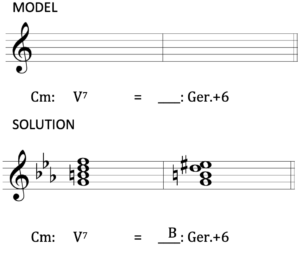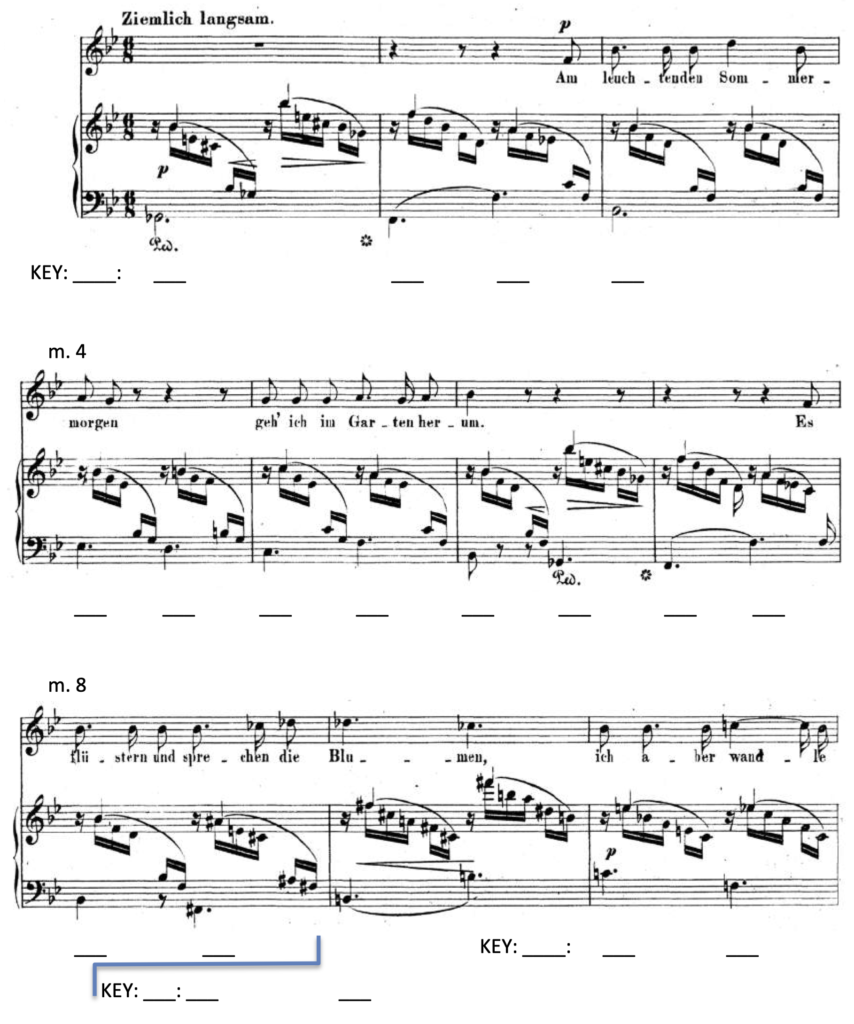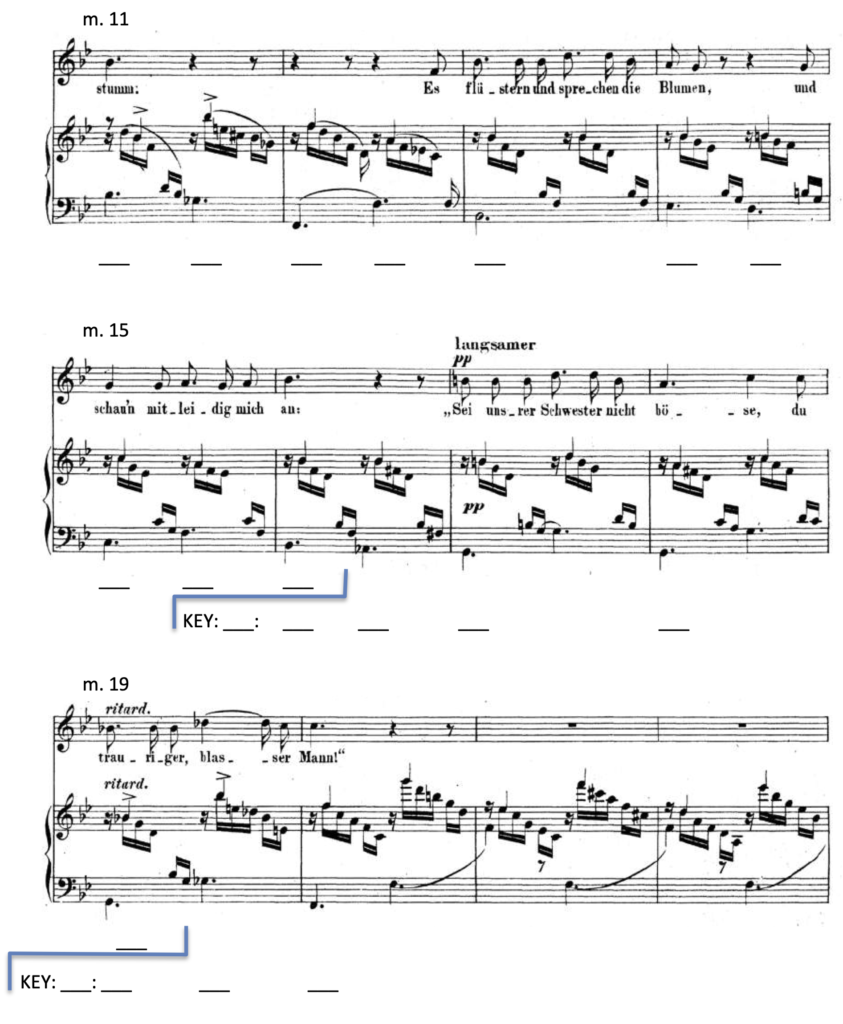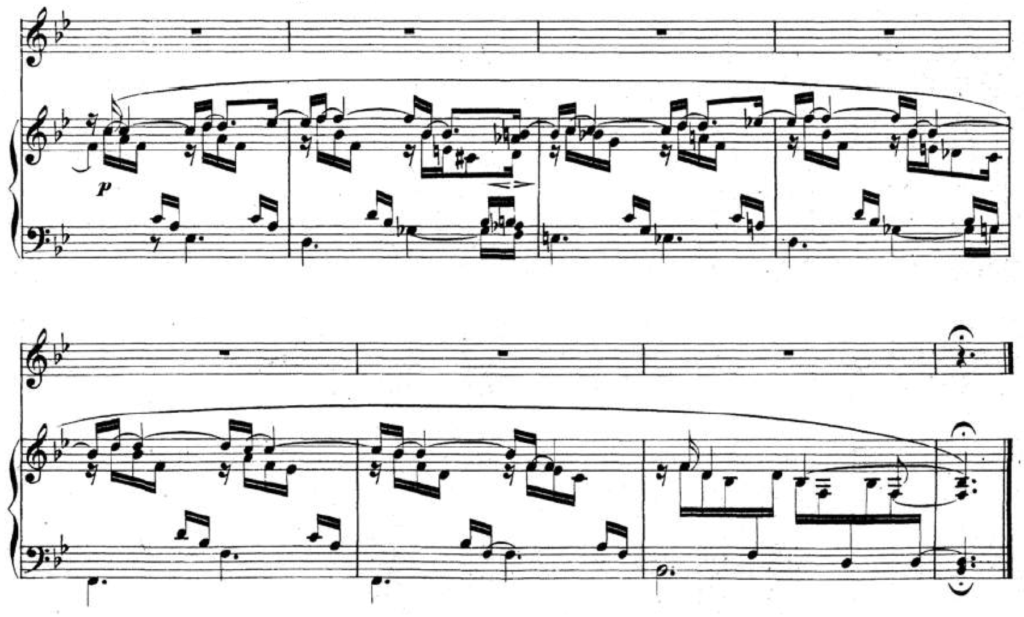Main Body
44 Enharmonic reinterpretation of V7 and Ger.+6
Learning goals for Chapter 44
In this chapter, we will learn:
- How chords may be reinterpreted enharmonically as a means of modulation to keys
- How to respell a V7 as a Ger.+6, and vice versa, to modulate to a distantly related key
- How enharmonic reinterpretation of V7 and Ger.+6 functions in musical contexts
- How to hear and transcribe enharmonic modulations
Enharmonic properties of V7 and Ger. +6
The is to a complete : both types sound like major-minor seventh chords, yet they are spelled differently. Likewise, the is enharmonically equivalent to an incomplete dominant seventh. Composers exploit enharmonic equivalence as an efficient means for modulation to distantly related keys.
Consider this: In C major, the V7 is spelled G–B–D–F. If V7 is respelled enharmonically as G–B–D–E![]() , it can be reinterpreted as the Ger+6 in the key of B major or B minor. Study and listen to this process in Example 44‑1.
, it can be reinterpreted as the Ger+6 in the key of B major or B minor. Study and listen to this process in Example 44‑1.
Likewise, the process can be reversed. For example, in C major, the Ger+6 is spelled A![]() –C–E
–C–E![]() –F
–F![]() . If the Ger+6 is respelled enharmonically as A
. If the Ger+6 is respelled enharmonically as A![]() –C–E
–C–E![]() –G
–G![]() (or G
(or G![]() –B
–B![]() –D
–D![]() –F
–F![]() ), it can be reinterpreted in the key of D
), it can be reinterpreted in the key of D![]() major or C
major or C![]() minor (another enharmonic equivalence!) as V7. This process is shown in Example 44-2.
minor (another enharmonic equivalence!) as V7. This process is shown in Example 44-2.
Since any V7 chord is enharmonically equivalent to the German augmented sixth, secondary dominants can also be reinterpreted, leaving the possibilities wide open for sudden and swift modulations to many different foreign keys.
Video: T83 Enharmonic reinterpretation video 1: intro (6:44)
This video introduces the concept of using the enharmonic properties of V7 and +6 chords as a means of modulation to key areas.
Beethoven uses enharmonic reinterpretation to modulate from A![]() major to G minor in the fourth movement of his Piano Sonata no. 31. Listen to this excerpt (provided below in Example 44-3) and mark the pivot chord, key areas, and Roman numerals in mm. 113–16. If you get stuck, watch video T84, which walks you through this analysis.
major to G minor in the fourth movement of his Piano Sonata no. 31. Listen to this excerpt (provided below in Example 44-3) and mark the pivot chord, key areas, and Roman numerals in mm. 113–16. If you get stuck, watch video T84, which walks you through this analysis.
Example 44‑3. Ludwig van Beethoven, Piano Sonata no. 31, op. 110, mvt. 4, mm. 106–18

Listen to the full track, performed by Alfred Brendel, on Spotify.
Learn about German composer Ludwig van Beethoven (1770–1827) by reading this Oxford Music Online article, written by Joseph Kerman and others.
Video: T84 Enharmonic reinterpretation video 2: analysis (5:38)
In this video, we examine a passage from Beethoven’s op. 110, mvt. 4 (Example 44‑3), that features a striking enharmonic reinterpretation of V7 as Ger+6 to modulate from A![]() major to the distantly related key of G minor.
major to the distantly related key of G minor.
Spelling enharmonically reinterpreted chords
Once you feel confident with your understanding of enharmonic reinterpretation as a concept, you can apply your new knowledge by spelling dominant sevenths (major-minor seventh chords), respelling the notes to create enharmonically equivalent augmented sixth chords, and determining the implied key areas associated with each enharmonically equivalent chord. Video T85 walks you through how to do this, using the V7 in C minor as a model.
Video: T85 Enharmonic reinterpretation video 3: spelling (4:18)
This video demonstrates how to spell a V7 in the key of C minor and how to respell the same chord enharmonically as a Ger+6 in a new key.
EXERCISE 44-1 Chord spelling and reinterpretation
Provide a key signature for each of the problems below, and spell the given chord. Then respell the chord and identify the new key. The first problem is done as a model.
SET 1
SET 2
SET 3
SET 4
Analysis with enharmonic reinterpretation
EXERCISE 44-2 Analysis with enharmonic reinterpretation
Study and listen to the piece. Identify the key areas and label Roman numerals on the blanks provided beneath the staff for mm. 1–20, then answer the questions that follow.
Worksheet example 44‑1. Robert Schumann, “Am leuchtenden Sommermorgen,” from Dichterliebe, op. 48
Read an English translation of the song text (German poetry by Heinrich Heine) on lieder.net by baritone Paul Hindemith.
Listen to a recording of the song, performed by Fritz Wunderlich, on Spotify.
Learn about German composer Robert Schumann (1810–1856) by reading this Oxford Music Online article, written by John Daverio and Eric Sams.
- What is unusual about the very beginning of this song?
- Why might Schumann have begun this song in the way he did?
- There is a in the key of ____ in mm. 8–9. What is the relationship of this key area to the tonic key?
- There is a tonal cell in the key of ____ in mm. 16–19. What is the relationship of this key area to the tonic key?
- Describe all the uses of in this song.
Ear training with enharmonic reinterpretation
EXERCISE 44-3 Harmonic dictation with enharmonic reinterpretation of V7 and Ger.+6
This exercise will help you learn to aurally identify modulations to distantly related keys that use enharmonic reinterpretation of V7 and the German augmented sixth. For these exercises:
- Play the audio up to four times.
- Your goals are to identify the opening key based on the given context, to notate the soprano and bass parts, and to label Roman numerals beneath the staff. You should also indicate the key to which the passage modulates.
- Mark the place where you hear the shift occur.
- Analyze the context to determine the key to which the progression modulates. For these progressions, either V7 in the old key will become Ger.+6 in the new key (the old “sol” becomes “le” and resolves down by half step to the new “sol”), or Ger.+6 in the old key will become V7 in the new key (the old “le” becomes “sol” and resolves eventually to “do” in the new key).
These progressions appear in Appendix E as nos. 33–39.
MODULATING DICTATION 1
MODULATING DICTATION 2
MODULATING DICTATION 3
MODULATING DICTATION 4
MODULATING DICTATION 5
MODULATING DICTATION 6
MODULATING DICTATION 7
Listen to the audio examples featured in this chapter here: Spotify playlist for enharmonic reinterpretation
Supplemental resources for Chapter 44
type of key relationship in which the key signatures differ by more than one accidental
type of augmented sixth chord containing scale degrees flat-6, 1, flat-3, and sharp-4; abbreviated as "Ger.+6"
term referring to two notes, intervals, or chords that sound the same, but are spelled differently
major-minor seventh chord built on scale degree 5; spelled as a major triad with minor seventh between root and seventh
type of augmented sixth chord containing scale degrees flat-6, 1, and sharp-4; abbreviated as "It.+6"
short passage of music in a new key, longer than a tonicization but not a full modulation
use of chromatic chords that exist diatonically in the parallel major or minor mode










